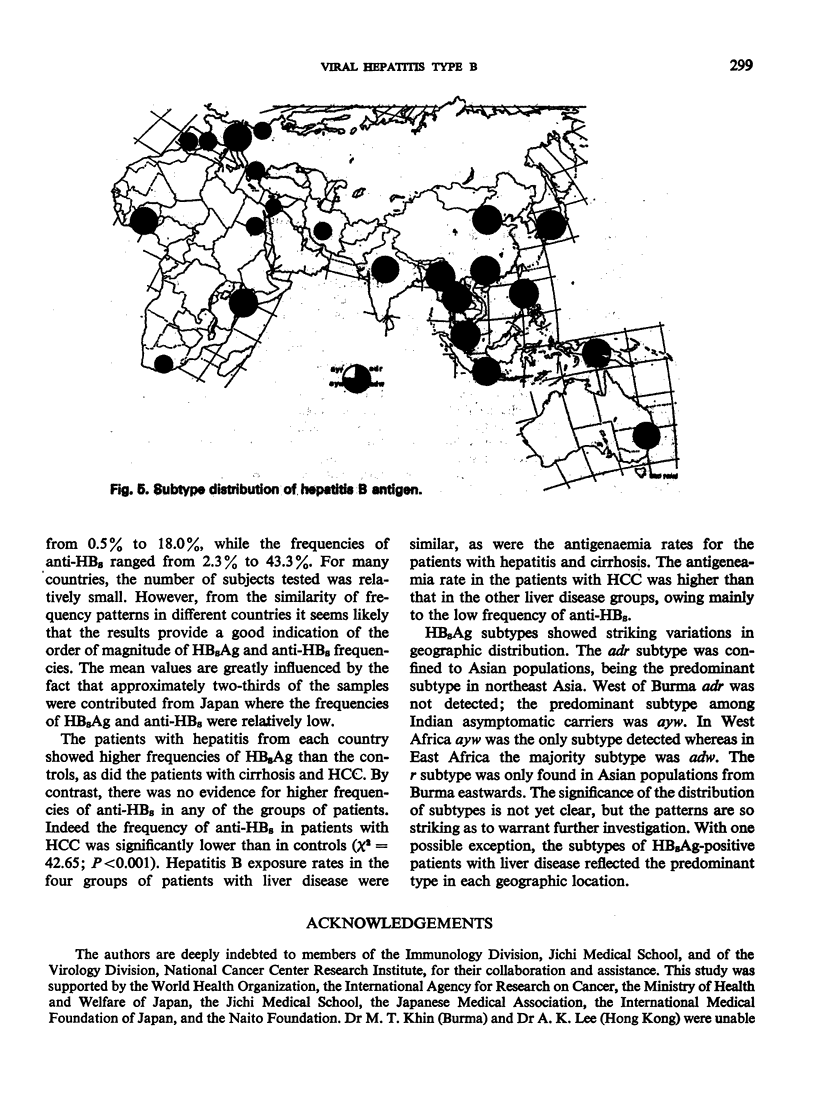Abstract
The relative sensitivities of counterimmunoelectrophoresis (CIE) and haemagglutination assays for the detection of hepatitis B surface antigen (HBsAg) and antibodies (anti-HBs) were compared. Twelve scientists from ten countries in Asia, Africa and the Pacific region participated in the study. The participants provided serum samples from 15 953 subjects comprising patients with acute and chronic hepatitis, cirrhosis, and hepatocellular carcinoma (HCC), as well as blood donors and other normal individuals. For the detection of HBsAg in a reference panel serum, immune adherence haemagglutination (IAHA) was slightly more sensitive than passive haemagglutination inhibition (PHI); CIE was the least sensitive. Mean HBsAg frequencies in patients with acute hepatitis, chronic hepatitis, cirrhosis, and HCC were significantly higher than in healthy controls. Passive haemagglutination (PHA) was more sensitive than CIE for the detection of anti-HBs. The frequency of anti-HBs in patients with HCC was significantly lower than that in the other groups. Mean anti-HBs frequencies in patients with acute hepatitis, chronic hepatitis, and cirrhosis were not significantly different from that in normal subjects. Subtyping of HBsAg was performed by PHI. Among asymptomatic carriers the predominant HBsAg subtype in northeast Asia was adr.In India, ayw predominated in carriers, with the demarcation between adr and ayw occurring west of Burma. In West Africa the only subtype detected was ayw, but in East Africa the majority subtype was adw. The r subtype was found only in Asian populations east of India and in Western Pacific populations. In Papua New Guinea all four subtypes were identified. With one possible exception, the subtypes of HBsAg-positive patients with liver disease reflected the predominant type in each geographic location.
Full text
PDF







Selected References
These references are in PubMed. This may not be the complete list of references from this article.
- Bayer M. E., Blumberg B. S., Werner B. Particles associated with Australia antigen in the sera of patients with leukaemia, Down's Syndrome and hepatitis. Nature. 1968 Jun 15;218(5146):1057–1059. doi: 10.1038/2181057a0. [DOI] [PubMed] [Google Scholar]
- Imai M., Yamashita Y., Miyakawa Y., Mayumi M. Haemagglutination inhibition assay of the common determinants and subspecificities of Australia antigen. Immunology. 1974 Nov;27(5):871–878. [PMC free article] [PubMed] [Google Scholar]
- Mazzur S., Burgert S., Blumberg B. S. Geographical distribution of Australia antigen determinants d, y and w. Nature. 1974 Jan 4;247(5435):38–40. doi: 10.1038/247038a0. [DOI] [PubMed] [Google Scholar]
- Smith J. B., Blumberg B. S. Viral hepatitis, postnecrotic cirrhosis, and hepatocellular carcinoma. Lancet. 1969 Nov 1;2(7627):953–953. doi: 10.1016/s0140-6736(69)90604-7. [DOI] [PubMed] [Google Scholar]


